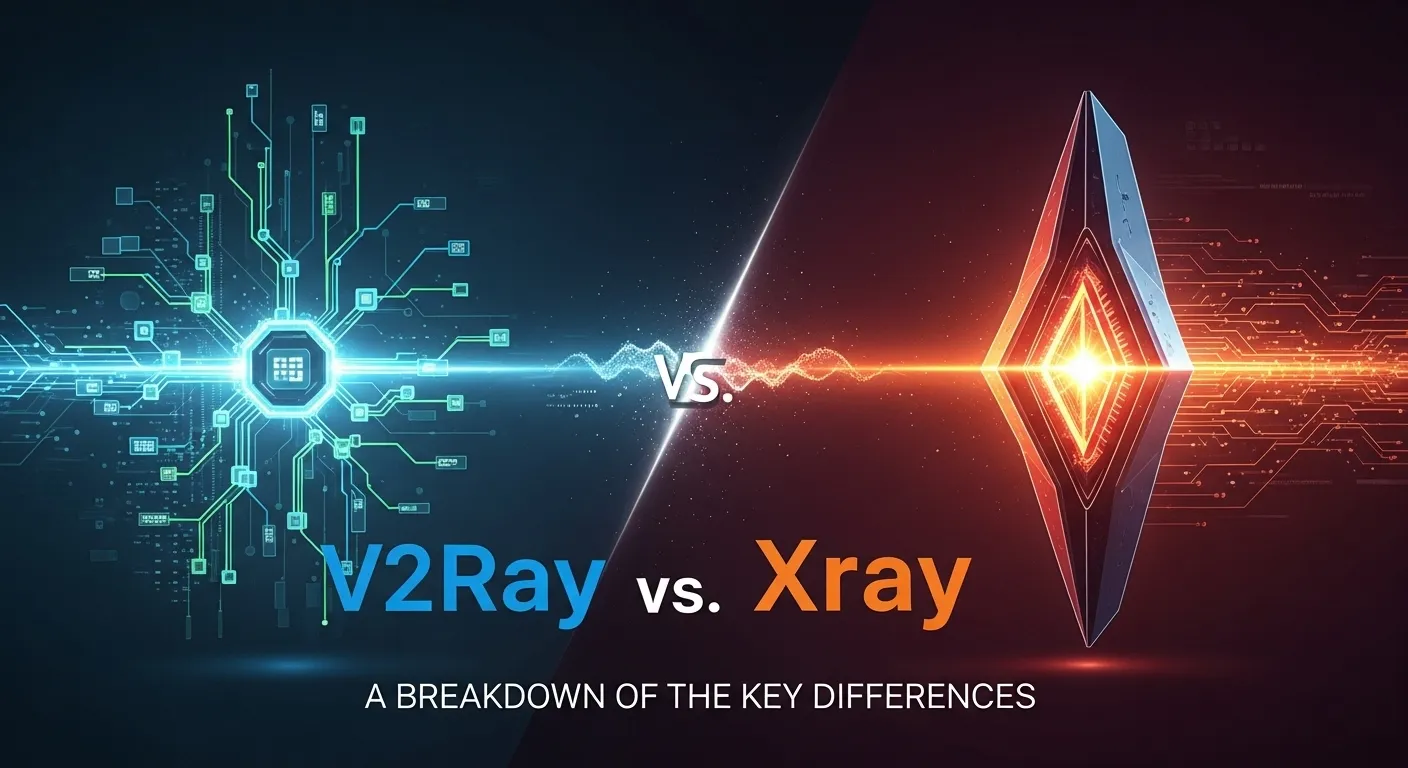In the intricate world of internet security and censorship circumvention, few tools are as powerful or as widely discussed as V2Ray and its high-performance counterpart, Xray. For users seeking to secure their connections, bypass geo-restrictions, or simply gain more control over their network traffic, choosing the right core engine is a critical decision. However, the close relationship and technical overlap between these two projects often lead to confusion. Many users, from beginners to seasoned administrators, find themselves asking: what is the difference between v2ray and xray? This question isn't just about picking a name; it's about understanding fundamental differences in philosophy, performance, and features that can significantly impact your online experience. This article will provide a comprehensive breakdown, demystifying the two projects and empowering you to make an informed choice.
Table of Contents
ToggleThe Genesis Story: Understanding Project V, V2Ray, and the Birth of Xray
To truly grasp the differences between V2Ray and Xray, one must first understand their shared origin. Both are born from Project V, an ambitious collection of tools designed to build a private and secure network platform. It was never just a single piece of software but an entire ecosystem. V2Ray was the original, and for a long time, the sole core component of Project V. It was created to be an incredibly flexible and modular platform, a successor to the widely used Shadowsocks, offering more protocols and intricate routing capabilities to combat sophisticated censorship mechanisms like Deep Packet Inspection (DPI).
V2Ray, under the stewardship of the V2Fly community, established itself as the gold standard for robust proxy solutions. Its strength lay in its versatility. With support for multiple protocols like VMess, TCP, mKCP, and WebSocket, it allowed users to craft complex configurations that could effectively disguise their traffic and navigate restrictive networks. The focus was on resilience and adaptability. The V2Ray core became synonymous with Project V itself, a testament to its foundational role and widespread adoption across the globe.
However, as with many successful open-source projects, differing opinions on the future direction emerged. A prominent developer within the V2Ray community, known by the alias 'rprx', envisioned a path that prioritized raw performance and cutting-edge features above all else. This led to a "fork" of the V2Ray project in late 2020, creating what is now known as Xray. The split was not born of malice, but of a different technical philosophy. Xray’s primary goal was to push the boundaries of speed and efficiency, starting with the introduction of its flagship feature, the XTLS protocol. This marked the clear divergence: V2Ray continued on its path of stable, versatile development, while Xray blazed a new trail focused on maximum performance.
Core Architecture and Performance: The Under-the-Hood Battle
The most significant and debated differences between V2Ray and Xray lie in their core architecture and the resulting performance metrics. While they share a common codebase heritage, their developmental paths have led to distinct optimizations that cater to different user priorities.
- #### V2Ray's Architectural Philosophy
V2Ray’s architecture is built on a foundation of modularity and stability. It was designed to be a “platform” where various inbound and outbound protocols could be connected through a sophisticated internal routing system. This allows for immense flexibility, such as receiving traffic via the VMess protocol and routing it out through a different protocol based on the destination domain. This modularity, while powerful, can introduce a slight overhead compared to a more streamlined, single-purpose design.
The V2Ray core, managed by the V2Fly community, prioritizes thorough testing and backward compatibility. New features are often integrated more cautiously to ensure they don't disrupt existing setups for its large user base. For many, this "slow and steady" approach is a significant advantage, as it translates to a highly reliable and predictable tool. Its performance is more than adequate for most use cases, including streaming HD video and general browsing, but it wasn't explicitly optimized for the lowest possible latency or highest throughput from day one.
- #### Xray's Performance-First Approach
Xray was forked with the explicit purpose of maximizing performance. The developer re-architected critical parts of the data flow to reduce latency and CPU usage. The most notable innovation is the XTLS protocol, which is a key differentiator. In a typical TLS-based proxy (like V2Ray with TLS), data is encrypted twice: once by the inner protocol (like VMess) and again by the outer TLS layer. XTLS cleverly eliminates this redundancy by directly using the outer TLS session to encrypt the data, a method often described as “TLS-in-TLS.”
This reduction in cryptographic overhead results in a measurable decrease in latency and a significant increase in throughput, especially on connections where CPU is the bottleneck. Beyond XTLS, Xray has incorporated other performance-enhancing features like advanced flow control modes (`xtls-rprx-vision` and `xtls-rprx-direct`), which further optimize how data packets are handled. This relentless focus on speed makes Xray a compelling choice for activities where every millisecond counts, such as competitive online gaming, high-frequency trading, or ultra-high-definition video streaming.
- #### Real-World Speed and Latency
In benchmark tests and real-world usage, Xray consistently demonstrates a performance advantage over V2Ray, particularly when using its specialized protocols like VLESS over XTLS. Users often report lower ping times and higher download/upload speeds with Xray, sometimes seeing improvements of 10-30% or more depending on the server hardware, network conditions, and specific configuration used.
However, it's crucial to put this into perspective. For a user with a slow internet connection (e.g., under 50 Mbps), the performance difference between V2Ray and Xray might be negligible for everyday tasks like web browsing or social media. The gap becomes more apparent on high-speed gigabit connections or in latency-sensitive applications. Therefore, while Xray is objectively faster in a direct comparison, V2Ray remains a perfectly performant solution for the vast majority of users.
Protocol Support and Innovation: VMess, VLESS, and Beyond
The protocols used for communication are the heart of any proxy tool. They define how data is encrypted, authenticated, and transported between the client and the server. Both V2Ray and Xray support a rich set of protocols, but their focus and innovations differ.
- #### The Legacy and Evolution of VMess
VMess is the original, stateful protocol developed for V2Ray. It is incredibly feature-rich, designed with security and obfuscation in mind. It uses a user ID (UUID) for authentication and has built-in dynamic port functionality and complex encryption mechanisms. Its primary goal was to be robust and resistant to detection by advanced firewalls.
While powerful, VMess has been criticized for its complexity and slight performance overhead compared to newer, leaner protocols. It remains fully supported and widely used in both V2Ray and Xray, making it a reliable choice for users who prioritize its specific security features. However, the development community's focus has largely shifted towards a more modern and efficient alternative.
- #### VLESS: The Lean and Mean Successor
VLESS was conceived as a high-performance, stateless protocol that addresses the perceived shortcomings of VMess. Its design philosophy is “protocol-less,” meaning it doesn’t contain its own encryption layer. Instead, it’s designed to be a lightweight data transport carrier that is almost always paired with an underlying transport layer security, like TLS or the innovative XTLS. Authentication is still handled by a UUID, but the protocol itself is much simpler.
VLESS is a crucial point of convergence: it is fully supported by both V2Ray and Xray. It has become the de facto standard for new deployments due to its superior performance. While V2Ray fully implements the VLESS specification, Xray has often been the first to introduce advanced features and flow control mechanisms specifically for VLESS, reinforcing its position as the performance-oriented core.
- #### XTLS and Other Xray-Specific Innovations
XTLS is, without a doubt, Xray’s killer feature. As mentioned earlier, it redefines how data is handled within a TLS tunnel. By avoiding the double-encryption pitfall, it provides a direct, low-latency path for your data. This is an innovation exclusive to the Xray core and is the primary reason many performance-seeking users migrate from V2Ray.
To use XTLS, you must use the VLESS protocol, as they are designed to work in tandem. This VLESS+XTLS combination is widely regarded as the highest-performance setup available in the ecosystem. Xray's development continues to be fast-paced, with the project frequently introducing experimental features and optimizations aimed at further improving speed and efficiency, cementing its reputation as the innovative, bleeding-edge choice.
A Comparative Look at Features and Configuration
When choosing between V2Ray and Xray, it’s helpful to see a direct comparison of their key attributes. While they are similar in many ways, their defining characteristics are distinct. Understanding these can help you align your choice with your technical needs and comfort level.
One of the most user-friendly aspects of this ecosystem is the configuration file format. Both V2Ray and Xray use a JSON-based configuration file. This is a massive benefit for users considering a switch. In most cases, a configuration file written for V2Ray will work with Xray with minimal or even no changes. Xray was designed with excellent backward compatibility in mind, ensuring a smooth migration path. You can often just replace the V2Ray executable with the Xray executable and restart the service.
This compatibility is a strategic masterstroke, as it lowered the barrier to entry for existing V2Ray users to sample Xray’s performance benefits. The main difference in configuration arises only when you want to use Xray-exclusive features, like XTLS. To enable XTLS, you need to add a `"flow": "xtls-rprx-direct"` (or similar) field to your VLESS inbound/outbound settings, a field that V2Ray will simply ignore.
Here is a table summarizing the key points of comparison:

| Feature | V2Ray (V2Fly) | Xray | Notes |
|---|---|---|---|
| Core Philosophy | Stability, modularity, and backward compatibility. | Peak performance, innovation, and efficiency. | V2Ray is the conservative, reliable choice; Xray is the aggressive, performance-focused choice. |
| Key Innovation | A flexible platform with rich routing capabilities. | XTLS protocol for significantly reduced latency. | XTLS is Xray's main selling point and a major performance booster. |
| Primary Protocol | Originally VMess, now heavily supports VLESS. | VLESS, especially in combination with XTLS. | Both support VLESS and VMess, but Xray is built around optimizing the VLESS experience. |
| Performance | Very good; sufficient for most users and use cases. | Excellent; industry-leading for this class of tool. | Xray generally offers higher throughput and lower latency, especially on fast connections. |
| Development Pace | Slower, more deliberate, and focused on stability. | Faster, more agile, and willing to introduce experimental features. | Xray's community is developer-driven and moves quickly. |
| Community & Docs | Larger, more established user base with extensive docs. | Growing community, often more technical in nature. | Beginners may find V2Ray's extensive documentation and tutorials easier to navigate. |
| Configuration | JSON-based. | JSON-based, and highly backward-compatible with V2Ray. | An Xray core can typically run a V2Ray config file without modification. |
Community, Development, and Future Trajectory
A project's long-term viability is heavily influenced by its community and development activity. In this regard, V2Ray and Xray represent two different models of open-source stewardship, each with its own strengths.
The V2Ray project, managed by the V2Fly community, boasts a large and mature ecosystem. Having been the standard for years, it has a vast amount of documentation, tutorials, and third-party client applications built around it. This makes it exceptionally welcoming for beginners. If you encounter a problem, there's a high probability that someone has already solved it and written a guide. The development is community-driven, with changes being proposed, debated, and thoroughly vetted before being merged. This ensures a high degree of stability.
The Xray community, while smaller, is vibrant and highly focused. Its development is led by its original creator, 'rprx', giving it a very clear and decisive direction: the pursuit of performance. New releases are frequent, often packed with optimizations and new features. The community discussions tend to be more technical, centered around benchmarks, protocol design, and low-level code implementation. This environment is perfect for advanced users and developers who want to be on the cutting edge.
Looking to the future, it's likely that these two projects will continue to coexist and even push each other forward. V2Ray will remain the bedrock—the stable, reliable, and universally compatible option. Xray will continue to be the spearhead of innovation, pioneering new techniques for speed and efficiency. The good news for users is that because of their shared heritage and protocol compatibility (especially with VLESS), the ecosystem as a whole becomes stronger. Innovations in Xray can inspire future developments in V2Ray, and V2Ray's stability provides a solid foundation for everyone.
FAQ: Answering Your Burning Questions
Q1: For a beginner, which one is better, V2Ray or Xray?
A: For absolute beginners, V2Ray is often the recommended starting point. The primary reason is the sheer volume of high-quality documentation, user guides, and community support available. Its stable nature means you are less likely to encounter issues from a brand-new, experimental feature. However, because Xray is backward-compatible, starting with Xray and using a standard VLESS+TCP+TLS configuration (which works identically to V2Ray) is also a perfectly valid and future-proof strategy.
Q2: Is Xray more secure than V2Ray?
A: Not inherently. Security is determined by the protocols and configurations you use, not the core itself. Both V2Ray and Xray implement standard, robust cryptographic libraries. A well-configured VLESS+TLS setup on V2Ray is just as secure as the same setup on Xray. Xray's main advantage with XTLS is performance, not enhanced security. It achieves speed by reducing cryptographic redundancy, not by using weaker encryption.
Q3: Can I use V2Ray client applications (like v2rayN or v2rayNG) with an Xray server?
A: Yes, absolutely. This is one of the biggest strengths of the ecosystem. As long as the client and server are configured to use a compatible protocol (like VMess or VLESS), they can communicate perfectly. You can run an Xray core on your server for maximum performance and connect to it using popular client apps that might have "v2ray" in their name. The clients only need to support the protocol you're using.
Q4: Is migrating from a V2Ray server to an Xray server difficult?
A: No, it is remarkably easy. For a basic setup, the process is as simple as stopping the V2Ray service, replacing the V2Ray executable file with the Xray executable file, and starting the service again. Because Xray is designed to be a drop-in replacement, it will read your existing `config.json` file and run without issue. You would only need to edit the configuration file if you want to enable Xray-specific features like XTLS.
Conclusion
The V2Ray vs. Xray debate is not about a "winner" and a "loser." Rather, it's about a mature, stable platform and its high-performance, innovative offspring. V2Ray, under the V2Fly community, stands as a testament to reliability and flexibility. It is the trusted workhorse of the internet freedom toolkit, boasting extensive documentation and a massive user base, making it an ideal choice for those who prioritize stability and ease of entry.
On the other hand, Xray represents the cutting edge. Born from a desire for ultimate performance, it pushes the boundaries of speed and efficiency with innovations like the XTLS protocol. It is the choice for power users, gamers, and anyone for whom low latency and high throughput are paramount. Its excellent backward compatibility with V2Ray makes it an easy upgrade for those looking to squeeze every drop of performance from their connection.
Ultimately, the best choice depends on your specific needs:
- Choose V2Ray if you value stability, extensive documentation, and a mature ecosystem.
- Choose Xray if you crave the absolute best performance, want the latest features, and are comfortable with a faster-paced development cycle.
Fortunately, thanks to their shared DNA and protocol compatibility, you can't make a wrong choice. Both are phenomenal tools that play a vital role in keeping the internet open and secure.
***
Summary
The article, "V2Ray vs. Xray: A Breakdown of the Key Differences," provides an in-depth, SEO-optimized comparison of two leading internet proxy tools. It begins by explaining their shared origin in Project V, clarifying that Xray is a high-performance fork of V2Ray, created to prioritize speed and efficiency.
The core differences are broken down into several key areas:
- Philosophy & Performance: V2Ray prioritizes stability, modularity, and backward compatibility, making it a reliable and robust choice. Xray, in contrast, is built for maximum performance, featuring architectural optimizations and its flagship XTLS protocol, which reduces cryptographic overhead for lower latency and higher throughput.
- Protocols: Both support the modern VLESS protocol and the legacy VMess protocol. However, Xray is the pioneer of XTLS, a feature designed to work with VLESS to achieve top-tier performance, a key differentiator that V2Ray lacks.
- Configuration & Compatibility: Both tools use a nearly identical JSON configuration format. Xray is designed as a "drop-in replacement" for V2Ray, meaning it can use V2Ray configuration files with little to no modification, ensuring an easy migration path for users seeking better performance.
- Community & Development: V2Ray has a larger, more established community (V2Fly) with extensive documentation, making it beginner-friendly. Xray's community is more developer-centric, with a faster-paced development cycle focused on cutting-edge features.
The article concludes that the choice is user-dependent: V2Ray is ideal for those who need stability and comprehensive support, while Xray is the go-to for power users, gamers, and anyone demanding the highest possible speed. An FAQ section further clarifies common questions about security, client compatibility, and migration.

















